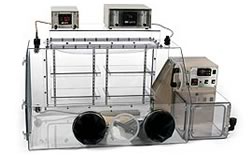Recent News & Events
Hypoxic Conditions for Cell Cultivation is Providing Significant Benefits to Researchers!
07
 Want to know more about cell culture environments and how you can benefit from the plethora of advantages available to you when you cultivate under hypoxic conditions? After reading this concise yet informative article you will gain an understanding of the factors that plague traditional cell culturing and how using hypoxic conditions to cultivate cells will benefit your research by reducing these factors.
Want to know more about cell culture environments and how you can benefit from the plethora of advantages available to you when you cultivate under hypoxic conditions? After reading this concise yet informative article you will gain an understanding of the factors that plague traditional cell culturing and how using hypoxic conditions to cultivate cells will benefit your research by reducing these factors.
Traditional Cell Culturing
As one of the major tools for studying the normal physiology and biochemistry of cells, it is important that you get the most from your research. So firstly what is cell culturing? Cell culturing is the removal of cells so they can be grown in an artificial environment. Cells can be removed via enzymatic or mechanical action or they can be derived from an already established cell line.
Cell culturing requires a sterile environment which is typically achieved with the use of a Bio-Safety Cabinet. Other standard laboratory equipment including incubators, water baths, aspiration pumps, cell counters and others are also used depending on their availability and the specific requirements.
The conditions for a cell culture are varied dependent upon the cells that are being cultured, but many of the factors can be manipulated to suit the culturing environment. The most common conditions to be considered are the gaseous environment (% of CO2 added to the atmospheric air) and temperature. For example, the common environment choice for mammalian cells is 37 °C with 5% CO2. Other factors can include nutrient concentration, hormone concentration, pH, osmotic pressure, glucose concentration, plating factors, anchorage dependence and growth factors.
However, despite having many controllable factors, tradition cell culturing has its complications. Nutrient depletion, pH changes, accumulation of dead cells, contact inhibition, cellular differentiation, cell line misidentification, contamination with mycoplasma, genotypic and phenotypic instability and natural selection of cells can all cause potential issues with the culturing process.
Culturing Under Hypoxic Conditions
New ways have been developed to mimic the cells in-vivo. One of which is by using hypoxic (oxygenated) conditions instead of the traditional CO2 environment. Hypoxic conditions allow cells to be cultured in a controlled oxygenated atmosphere. Traditional cultivation uses the air composition found in the Earth’s atmosphere, meaning that the oxygen levels are around 21%. By controlling the oxygen conditions, cells can be cultured in low oxygen environments similar to those found in the body (1-12%). This gives conditions close to the native environment for mammalian cells. Hypoxic conditions reduce some of the problematic factors by introducing lower stresses, reducing DNA damage, faster cell growth and increasing the life span of the cells by up to 25% longer.
It has been shown that culturing mammalian immune cells in a low oxygen atmosphere allows them to grow and behave naturally. When placed in atmospheric oxygen, the cells become confused and send signals as if they are fighting an infection. Stem cells are another type of cell that benefit from hypoxic conditions. The low oxygen atmosphere allows the cells to maintain their normal characteristics which prevents them from differentiating. These are just a couple of the many studied cell types that benefit from hypoxic conditions.
To maintain a hypoxic atmosphere, a specialized hypoxic chamber is required. A hypoxic chamber is a specially sealed unit containing glove ports and air locks to maintain a constant atmosphere when reagents are added or removed. Oxygen electrodes can also be contained within a hypoxic chamber to monitor the oxygen concentrations. In order to meet the demand for hypoxic chambers, many manufacturers have just adapted standard glove boxes with an incubator. Because of this, cross-contamination is an issue with many of them. Many boxes also include single incubators. Single incubators however don’t always provide an accurate hypoxic atmosphere because the gases can’t be controlled easily.
The most common and easiest way to achieve hypoxic conditions is by using a tri-gas Incubator. Nitrogen gas is used to displace and reduce the oxygen levels in the incubator, typically to 0.5-2%. Tri-gas incubators currently provide the closest conditions to that of the body because of their controllability of all 3 gases (CO2, O2 and N2). However, the hypoxic atmosphere disappears when the incubator doors are opened or cultures are removed and the cells will begin to deteriorate at an accelerated rate depending on the size of the sample, how it’s contained and other relevant factors.
